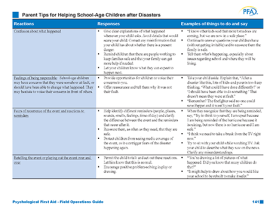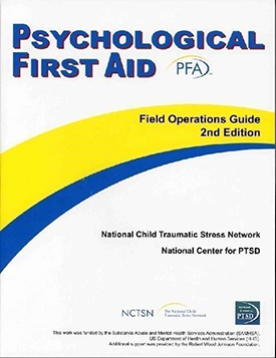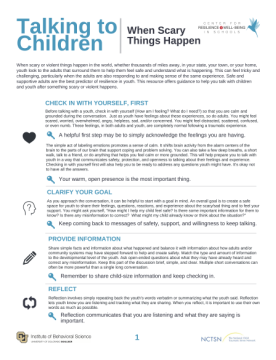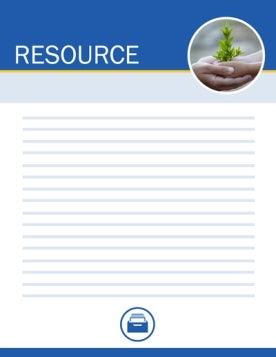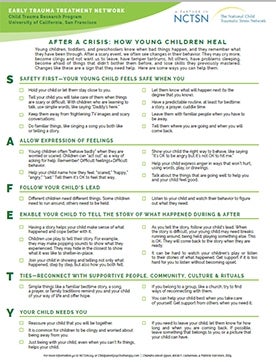Landslides are the movement of masses of rock, debris, or earth down a slope. Rainfall, snowmelt, earthquakes, volcanic activity, changes in water level, stream erosion, or human modification of the land typically activate landslides. Debris and mudflows (also called mudslides) are rivers of rock, earth, and other debris soaked in water. They’re created when water builds up quickly in the ground during and after a heavy rainfall or rapid snowmelt. The danger can last days or weeks after the rains stop. Landslides can move slowly or can move quickly, as in the case with debris flows.
Being prepared beforehand is the best way to help children and family members recover after a landslide. To improve their preparedness, families should:
- Understand landslides and debris flows can occur without warning and can flow quickly. During these times they require immediate action and families may not have time to grab their belongings in the event of an evacuation. Many occur at night when people are sleeping. As a precaution, families in high risk areas may want to evacuate to a friend’s or family member’s home during heavy rainstorms.
- Identify high-risk areas for landslides. Families should learn whether landslides or debris flows have occurred in their area in the past and if they are in a landslide-prone area. High-risk areas for landslides include:
- Areas where wildfires or human modification have destroyed vegetation
- Areas where landslides have occurred before
- Steep slopes and areas at the bottom of slopes or canyons
- Slopes that have been altered for construction of buildings and roads
- Channels along a stream or river
- Areas where surface runoff is directed
- Know the warning signs of a potential landslide. Patterns of storm-water drainage on slopes near homes, especially where runoff water converges, can indicate increased risk. Additional warning signs include doors or windows beginning to stick that haven’t in the past, small slides or debris flows or progressively tilting trees, or the sounds of trees cracking or boulders knocking together that might indicate moving debris.
- Understand the different landslide and flood warnings:
- Landslide Advisories: Indicate the potential of landslide activity in an area relative to developing rainfall predictions.
- Landslide Watch: A landslide is possible but not imminent. People in the area should check preparedness alerts and stay informed about developing weather patterns.
- Landslide Warning: Means that a landslide is occurring and people should take extreme caution.
- Flood Watch: Indicates that an overflow of water from a river is possible for the watch area.
- Flash Flood Watch: Indicates that flash flooding is possible in or close to the watch area.
- Flood Warning: Indicates that flooding conditions are occurring in the warning area.
- Flash Flood Warning: Indicates flash flooding is occurring in the warning area.
- Reduce the landslide risk on their property. Families should work with local officials or a geotechnical expert to get a ground assessment of their property and advice on reducing landslide risks.
- Develop an evacuation plan. Families should know the best evacuation routes, and should practice them annually during both the day and night.
- Assemble an emergency go kit. Families should have access to enough water, food, and other emergency supplies for at least 3 days and medications for at least 7 days. They should also gather copies of important documents, a radio with batteries to get weather updates, and supplies for pets. Children can also pack their own kits and include their favorite toys. For a checklist of what to include, review the family preparedness plan.
- Make a family communication plan. Families should have important contact information easily accessible and they should know who they might contact when they are separated from one another. Babysitters should also be aware of this important information. The preparedness wallet card can help families keep track of their contacts.
- Plan for children’s needs. Parents and caregivers should give children factual information about landslides and debris flows in simple terms. They should also know what the emergency plan is at their children’s schools or after-school programs. Parents can include children in preparedness activities. The mobile app Help Kids Cope provides information on how to talk with children of different developmental levels.
Knowing what to do during a landslide can help families feel more in control and take steps to increase their safety. Consider the following:
During a landslide watch or warning, families should:
- Stay informed about landslide alerts and current weather updates. Families should listen to local official radio or television stations for the latest emergency information.
- Stay alert and awake. Many debris-flow fatalities occur when people are sleeping, so families should be vigilant for any changes during landslide warnings. They can also consider staying with a friend or family member if in a high-risk area and it’s safe to drive.
- Monitor landslide warning signs. Remind families to watch for warning signs such as small slides or debris flows; tilted trees, telephone poles, fences, or walls; doors suddenly sticking; unusual sounds of moving debris; or new holes or bare spots on hillsides. Changes in water level of nearby streams and changes in water quality (from clear to muddy) might also indicate a debris flow upstream. If they see any of these, families should alert the authorities and consider evacuation.
During a landslide or debris flow, families should:
- Quickly grab loved ones and pets and immediately get out of the path of the landslide or debris flow. Stay away from streams, creeks, and low-lying areas. They should continue to stay away from the slide area, as additional movements can happen for hours to days afterwards.
- Move to a higher level and take shelter if indoors. Families should move to a second story if possible or find cover in the section of the building that is furthest away from the approaching landslide. Sturdy furniture such as a table, desk, or bench can also provide shelter.
- Move to the nearest high ground if outdoors. Families should move out of the path of the slide and to the nearest high ground if outdoors. A group of trees or a building can provide shelter if debris and rocks are approaching.
- Practice safe driving if in a car. Families should watch the road for collapsed pavement, washed out bridges, mud and fallen rocks, and other indications of debris flow.
To address children’s reactions immediately after a landslide, parents and caregivers can:
- Model calm behavior. Children may mirror the reactions of adults around them and will learn ideas for how to take care of themselves from what parents and caregivers do.
- Provide simple but accurate information in a quiet, steady voice. Make sure they know the warning signs of a landslide/debris flow and where they need to evacuate if they notice any of these warnings.
- Encourage comforting or distracting activities. Children may benefit from doing slow breathing to calm their bodies or having a stuffed animal or blanket to hold. Because families may need to stay evacuated for a long period of time, engage children in simple activities to keep them distracted. For additional ideas, go here.
- Practice their own self-care. Parents and caregivers may benefit from finding opportunities to take a moment for themselves, express their feelings, acknowledge that it is a scary situation, and engage in a coping strategy.
Landslides often occur with little warning and can completely damage homes and businesses, requiring families to rebuild or relocate. In extreme instances, landslides can also block or damage roads, limiting access to some communities and delaying services. Because they can occur when families are separated, individuals may sometimes have to wait hours or even days to learn if their loved ones are safe. The reactions of children and families will vary, and may depend in part on how fearful they were, the extent of damage and loss they experienced, and the degree of disruption to the community. Children may express worry that another landslide will occur, become distressed when separated from parents or caregivers, have trouble concentrating or paying attention, or may report more headaches or stomachaches.
After a landslide, most families will recover over time, particularly with the support of family, friends, and community organizations. Some families will be able to return to their normal routines rather quickly, while others will have to contend with repairing damage to their home and possessions, finding medical care, needing new employment, moving to a new community, and facing financial hardship. To help children recover and adjust, parents and caregivers can:
- Model being calm and hopeful after the disaster.
- Provide accurate information and answer questions honestly.
- Be patient when responding to changes in behavior, such as difficulty going to bed or not wanting to sleep alone, clinging to loved ones, or seeking extra reassurance.
- Help children cope with reminders of the landslide, such as the sound of trees cracking or the sight of damaged homes.
- Maintain consistent routines and family norms.
- Attend to their own well-being, as children’s functioning and recovery will be influenced by how their parents and caregivers cope
Below are resources to support children, families, and communities recover after a landslide.
